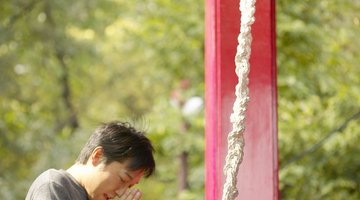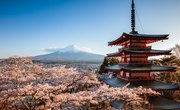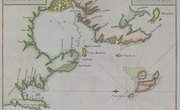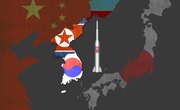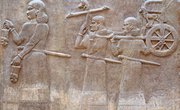Japan’s postwar constitution, adopted in 1946, calls for a separation of religion and state, and Japan no longer has an active military. However, prior to World War II, Shinto, Japan’s ancient and indigenous religion, was a leading factor in Japan’s military aggression.
Shinto
Shinto is the indigenous religion of Japan, dating back more than 2,000 years. Primarily based on the worship of nature, spirits and the ancestors, it is more a series of beliefs and rituals than a religion. From the sixth century on, however, adherents to Shinto believed that the first emperor was descended from the sun god. This belief system, later in history, would lead to disaster for Japan.
State Shinto
At the end of the 19th century, Shinto was reconstructed under Emperor Meiji. Meiji was declared a direct descendant of the gods; therefore all subsequent emperors were also considered manifest gods. The Japanese believed this gave them the inherent power to rule not only Japan but all the world. With the rise of the Japanese empire in the 19th century, state Shinto came into effect, making Shinto the official religion of Japan, and making the emperor commander-in-chief of the military, with the power to appoint generals, admirals and prime ministers. Schoolchildren bowed every morning before a photograph of the emperor, and were taught that he and all emperors were descended from the gods. In the 1930s, the Japanese believed Emperor Hirohito to be a god, superior to all others and worthy of unquestioning obedience -- a toxic combination with World War II looming.
Japan's Defeat in World War II
After the U.S. dropped atomic bombs on Hiroshima and Nagasaki, Japan surrendered officially in September 1945. In the wake of Japan’s defeat, three documents would change the course of history, dismantling Shinto as state religion: The Directive for the Disestablishment of State Shinto (1945), The Imperial Rescript Renouncing Divinity (1946) and the Post-War Constitution (1947). The Directive for the Disestablishment of State Shinto vowed to “prevent recurrence of the perversion of Shinto theory and beliefs into militaristic and ultra-nationalistic propaganda designed to delude the Japanese people and lead them into wars of aggression.” The Post-War Constitution’s Article 9 states "the Japanese people forever renounce war as a sovereign right of the nation and the threat or use of force as means of settling international disputes." After World War II, religion and state would be separate, and Japan would have no military power.
Modern-Day Japan
Today Japan has a population of over 125 million, yet 70 percent claim no religious membership. Though Shinto is still embedded in Japanese culture, there is no danger of history repeating itself because Japan’s postwar constitution prohibits it from forming a military. In its place, the Japan Self-Defense Forces was created, solely for self defense in case of attack by other countries. Its purpose is "to preserve Japan's peace, independence and safety." The JSF is most often involved with international peace-keeping missions.
Related Articles
References
Writer Bio
Hollye Dexter’s articles about mental health, parenting, women’s issues and activism have been widely published. Her book “Dancing at the Shame Prom” was praised by Gloria Feldt (CEO of Planned Parenthood) as “…a brilliant book that just might change your life.”

